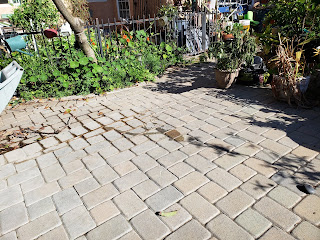This year was the year of the tomato. I planted 7 trays of tomatoes under my grow lights and in the blink of an eye I had over 100 seedlings ready to transplant. I didn't have any idea where they were going. I don't have that much empty space in the garden. In order to get some of them up and out into the yard I combined two of my favorite gardening techniques-composting and container gardening.
Today I'm "Lasagna gardening" in a pot. If you're not familiar with Lasagna gardening you're missing out on a terrific gardening method. In a nut shell, lasagna gardening "layers" brown and green organic materials (much like layers of lasagna), topping it with potting soil and planting directly in these "composting" beds. The book "Lasagna Gardening", by Pat Lanza is one of my favorites. It not only explains the whole process in great detail but also contains many tips and ideas for an easy care garden.
These tomato pots are not only quick and easy to put together but you probably have everything you need laying somewhere in your yard or garage.
5 gallon bucket (or a similar sized container)
tomato cages (or sturdy sticks and twine for a support system)
potting soil
shredded leaves
grass clippings
finished compost (if you have it)
fertilizer
tomato seedlings
labels & permanent ink pen
drill
Try local restaurants and donut shops if you're looking for 5 gallon buckets. Most places throw them out anyway so you can score them for free.
Add your shredded leaves first, filling your buckets about 3/4 full. Putting the leaves first adds bulk to the container and the leaves help drain excess water away from the plants roots.
Watering after each layer ensures you won't be planting in a dry mix.
Add your grass clippings next. A layer an inch or two thick will get the compost cooking. Don't forget to add more water.
If you have some finished (or partially finished) compost add it now. The bacteria, fungi and other decomposers will start turning your green waste into compost.
A dose of fertilizer will feed your plants and help replace important nutrients lost during the composting process.
Finish your pots with thoroughly moistened potting soil. It's easiest to do this in a wheelbarrow or other large container before adding it to the pots. You're giving your seedlings a bit of a shock just by transplanting them. Don't add to their stress by starting them in a "dry" home.
These tomato seedlings don't look like much now but just give them time (and water) and they will take off.
My seedlings are planted and ready to grow. Don't forget to label your containers.
As the leaves and grass decompose the soil level will drop. Tomatoes are the only edible plant (that I know of) that will grow roots out of the stem. Adding more potting soil will result in stronger, healthier plants.
The soil in potted plants leach nutrients with each watering. Be sure to fertilize more frequently, but at a lighter dose, than you would plants in the ground.
Interested in reading more about Lasagna Gardening? Try Hamiltonbook.com for a good deal on this book as well as other gardening books. Plus, there's always just one low price on shipping (no matter how many books you buy) and a "no questions asked" return policy.
June 09, 2013. I started these pots on April 16th. My plants are big and bushy with blossoms and fruit on all of the plants.
The Roma tomato already has clusters of fruit. It shouldn't be long before the other plants follow.
I think next year I will really go crazy and turn my boring driveway into a potted paradise.
Be well and happy gardening!
October 06, 2013. I got a very good crop of Beefsteak and Chadwick Cherry tomatoes from these pots. While the Roma tomato put out a lot of fruit, the whole crop had blossom end rot. I tried amending/fertilizing the soil with gypsum and tomato fertilizer but wasn't able to save any fruit. After the season ended I pulled out the plants and added the contents of the 5 gallon containers to the compost bin. The containers will be scrubbed clean and reused for fall crops.



















.JPG)






















